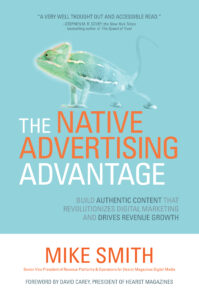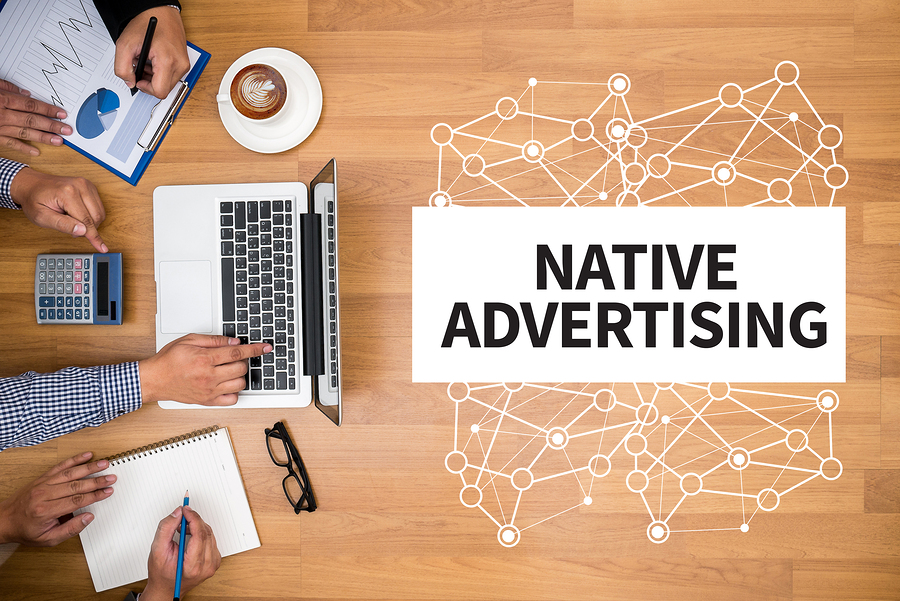The Fastest Growing Part of Advertising
Most of us don’t know what native advertising is, but it’s one of the fastest and most important growing parts of advertising today.
In fact, 40 percent of publishers expect it to drive at least a quarter of their revenue. Almost $10 billion will be spent on it in the next few years.
This is advertising that doesn’t quite look like advertising.
Knowledge is power. So it’s important to know what it is, how it works, and its effectiveness, whether you’re leading a marketing team or whether you’re simply a consumer of information.
Mike Smith is Senior Vice President of Revenue Platforms and Operations for Hearst Magazines Digital Media and Senior Vice President of Advertising Platforms for Hearst’s Core Audience. (Can you imagine fitting that title on your business card?)
I recently caught up with Mike to talk about his new book, The Native Advertising Advantage: Build Authentic Content that Revolutionizes Digital Marketing and Drives Revenue Growth.
Orange Is the New Black
For those who have yet to have the opportunity to read your book, what is native advertising and why is it so important?
Native advertising is a form of advertising where the ads are designed to fit the function and format of the web page or mobile page that it lives on. Native advertising is a multibillion dollar and growing marketplace. It is becoming the primary ad product sold by publishers, and it is an effective ad format for mobile screens. Display advertising or banner advertising is a byproduct of the ads that we saw in print, in newspapers and in magazines. Those banner ads, which we typically see on the top of or to the right of web pages on desktop computers, do not fit into mobile pages effectively. Native advertising, where the ad is designed into the flow of the content the user is reading has become a very viable alternative.
Traditional forms of advertising like display advertising are meant to disrupt the reading experience and invite a user to click on the banner and exit the website to read about the advertiser’s offer on the advertiser’s website. Instead, a native ad is meant to fit within the reading experience the user has chosen to visit.
 Native advertising is a superset category for various subcategories. One of those subcategories, which we’re all very familiar with, is paid search ads. When we go to Google we see at the top of the page the ads that Google has sold to advertisers. Those look very much like the natural search results that we get from Google. Another subcategory of native advertising is branded content. In the case of branded content, when we visit the NY Times or Elle.com or Esquire.com, we may go there to read a story that was published about a news event or about fashion, but we may also read stories that were published in collaboration with an advertising brand. This is disclosed as branded content. At the top of the article it will say this article was published by Elle in collaboration with a luxury advertiser brand. One of the most famous examples, which I discuss in my book, is the NY Times collaboration with Netflix for Orange Is the New Black.
Native advertising is a superset category for various subcategories. One of those subcategories, which we’re all very familiar with, is paid search ads. When we go to Google we see at the top of the page the ads that Google has sold to advertisers. Those look very much like the natural search results that we get from Google. Another subcategory of native advertising is branded content. In the case of branded content, when we visit the NY Times or Elle.com or Esquire.com, we may go there to read a story that was published about a news event or about fashion, but we may also read stories that were published in collaboration with an advertising brand. This is disclosed as branded content. At the top of the article it will say this article was published by Elle in collaboration with a luxury advertiser brand. One of the most famous examples, which I discuss in my book, is the NY Times collaboration with Netflix for Orange Is the New Black.
Why is native advertising on the rise?
It’s on the rise because advertisers are finding branded content to be a very effective way to engage consumers in partnership with publishers. All the different advertising sectors are adopting this new type of advertising in digital as a way to partner with publishers to reach consumers and engage them. And it’s very effective in particular on mobile devices, which is increasingly how consumers are reading content.
When is native advertising not OK?
The important part of native advertising and branded content in particular is disclosure. Disclosure is critical because native ads blend with the content. You want the user to be able to easily and effortlessly discern that what they’re reading was created in collaboration with an advertiser. So it’s not OK when disclosure is inadequate. Disclosure guidelines have been published by the Federal Trade Commission, and a guidebook has been published by the Interactive Advertising Bureau to offer publishers and advertisers specifications for how branded content and native advertising should be labeled. So it’s not OK when those specifications are not followed.
How to Recognize Native Advertising
How does the average reader recognize native advertising?
Through disclosure statements, typically at the top or adjacent to the ad itself. There is not today a standardized way to do it. You won’t find common language from publisher to publisher or from advertiser to advertiser. Each publisher has developed its own process and its own policy. There are publishers that give the advertiser direct access to their editorial content management system. Other publishers have branded content studios where there are people who often were journalists in the newsroom in the earlier part of their careers but who now work in branded content. Their job is to offer branded content developed in collaboration with the advertiser.
You talk about “brands that have gone native.” What does this mean? Where is this heading?
The digital paid search advertising marketplace in the United States in 2017 will be $35 billion. The display advertising marketplace in the United States in 2017 will also be $35 billion. It’s in part a consequence of more effective formats for mobile. The consumption of digital media is increasingly mobile. Every publisher measures its audience statistics, including the types of devices the audience is using to consume the publisher’s content. And it’s been some time now since most publishers have crossed the so-called 50 percent threshold, where 50% of the consumption of their content is on mobile. Now publishers are routinely seeing 80%+ mobile consumption. In this paradigm, branded content and native advertising are likely to grow more.
For more information, see The Native Advertising Advantage: Build Authentic Content that Revolutionizes Digital Marketing and Drives Revenue Growth.

